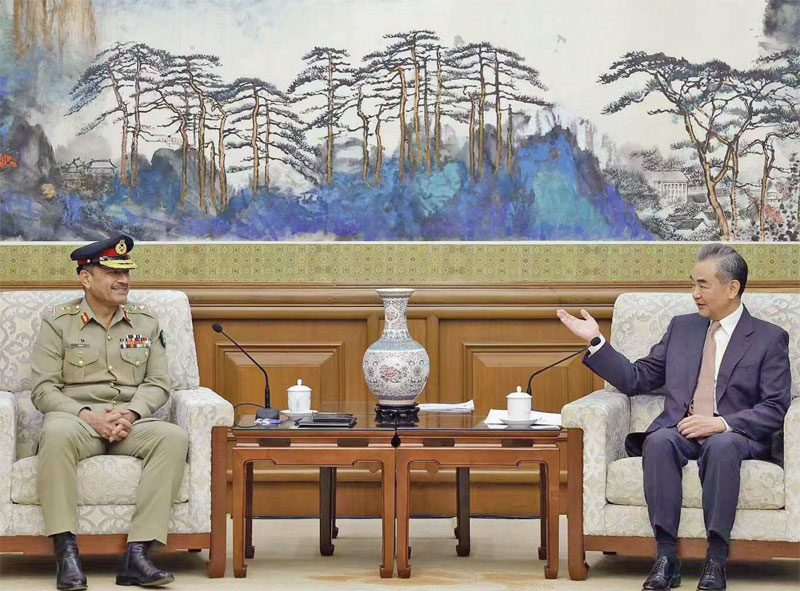Pakistan’s attempts to reset ties with China, US faces uncertainty
 Usama Nizamani
Usama Nizamani
The start of 2022 will go down as a year, at least for this decade, which drifted policymakers in Pakistan away from exercising prescient choices. The year coincided with the war breaking out between Russia and Ukraine, which impacted global supply chain configuration and forced countries, mostly in Asia, to play a delicate balancing act between great powers.
For Pakistan the challenges were multiple: grappling with uncertainty over Afghanistan; domestic politics fractured over the vote of no-confidence; subsequent domestic politics squabbles; and an approach of high-handedness by the central government to corner opposition and dissenting media; and lastly, the set off of disastrous floods, all of which have complicated choices for surmounting a fast-evolving geopolitical landscape. The course Pakistan takes will determine its position in the next two decades: either being adrift or astute at exercising strategic choices.
Road to Washington
The last plane to fly out of Kabul on 30 August 2021 with US officials, Maj. Gen. Christopher Donahue and Ambassador Ross Wilson concluded the US withdrawal from Afghanistan. Not only did it bring an end to the United States’ longest war, but it also left an indelible mark on the US-Pakistan relations, which were in search of a reset. Pakistan has long desired a strategic partnership with the US beyond Afghanistan and the confines of security-centred cooperation. For observers in the US, such an attempt was premature: the wounds over Afghanistan were yet not healed.
As much as this argument sounds old, the fact is simple. Pakistan and the US were actually pursuing parallel interests, despite overlapping interests. The wider common interests included fighting Al-Qaeda and other internationally designated terrorist groups that threatened Pakistan, the US and regional security. On things they diverged, the US blamed Pakistan for doing too little to coerce the Taliban and its Haqqani faction, while Pakistan feared being pressed from its western front, as on the eastern one by India, due to the presence of India’s security apparatus in Afghanistan. This in part motivated actions that often entangled both Pakistan and the US in protracted cycles of blame game, mutual distrust and pursuit of actions that ran in diametric conflict with each other’s respective interests.
For now, Afghanistan under the Taliban runs diametrically opposite to expectations. Promises it made to the international community have hardly been fulfilled. The Afghan soil continues to offer safe haven to terrorist groups, including the Tehreek e Taliban Pakistan, carrying out terror attacks in Pakistan. The Taliban government has carried out draconian measures against women by banning them from workspaces and denying them the fundamental right to education; and shown little interest in reconciling with opposition stakeholders. Thus, the failure to meet the least of the common denominators has made regional countries, including Pakistan balk at the idea of recognising Afghanistan under the Taliban.

All of this has taken place at a time when the Pakistan Democratic Movement, a coalition government seeks resetting of ties with the United States. With a more pronounced focus on non-security areas, a constant that finds resonance across the political divide in Pakistan. The country has sought investment in trade, technology and innovation, tourism, education, and research from the United States. South Asia experts in Washington advise in favour of slow and steady engagement. They suggest publicly as well as in private placing higher expectations may end in frustration. Thus, a call is made for achieving smaller milestones first.
Against this backdrop of pragmatic expectations, the outreach remains promising. The two countries have engaged in multiple rounds of talks, held both in Islamabad and Washington D.C., from security and defence, and bilateral trade, to cooperation on climate resilience under the green alliance framework. For Pakistan, the United States remains one of the biggest trading partners with bilateral trade at nearly USD 10 billion, with Pakistan enjoying a trade surplus. Yet, Pakistan’s overall exports for a 220 million nation hover at USD 31 billion. Between 2008-2018, the figure stagnated at USD 25 billion. An unimpressive mark by the world’s fifth-largest nation with minimum investment in global trade architecture. For now, bilateral trade with the US warrants serious reforms in policy, market, and investment architecture.
To Moscow
Russia’s invasion of Ukraine on 24 February 2022, coincided with a visit of a foreign dignitary to Moscow: Pakistan’s former Prime Minister Imran Khan. The former PM described the timing of the visit ‘unfortunate’ and in his later interview with Piers Morgan prevaricatingly condemned Russia’s violence. It came at a time that became the subject of domestic politics and Pakistan-US relations. Faced with the vote of no-confidence Khan accused the US officials of regime change conspiracy, an allegation the US State Department repeatedly denied. Yet, the damage to bilateral relations was real despite an ongoing low then. Above all, the aftermath of the war left Pakistan in the wilderness; wanting a proper narrative for its delicate act.
Its eastern neighbour India is now among the largest importers of Russian oil. From importing 1 per cent of its oil from Russia before the Russia-Ukraine conflict in February 2022, Russia currently makes up for 34 per cent of India’s oil imports. By March 2023, the share had risen to 1.64 million barrels per day and in April 2023, Russian oil imports overtook Iraq, becoming the top supplier of oil to India. Not only do India’s refineries remain busier than ever, it also exported refined products such as diesel and jet fuel to Europe. The continent accounted for 50 per cent of India’s jet fuel exports approximately 70,000-75,000 bpd in 2022-23, with an upward of 78 per cent rise from the previous fiscal year. Pakistan for the most part, struggled to convince itself and the world outside of the decision to import. After an almost a year of talks, the federal government has decided to procure crude oil from Russia.
Masood Khan, Pakistan’s Ambassador to the United States, admitted Pakistan was importing oil with the United States’ implicit approval. Similarly, US State Department official Vedant Patel, in response to a question on the country’s anticipated oil imports from Russia, acknowledged countries will ‘make its own sovereign decision as it relates to energy supply,’ while pressing them to adhere to G-7’s ‘price cap’ to prevent the country’s energy supplies from being ‘Putin’s war machine.’ Yet for Pakistan, a dearth of cogent arguments remains rife. There is hardly any convincing argument given to the outside world, especially the West, on why the country needs to import oil from Russia, especially in the midst of a lingering economic crisis, making the exercise look more like a political compulsion than a necessity.
Camp Politics
In December 2021, Pakistan announced its National Security Policy (NSP) while laying emphasis on human security, economic security and climate security. It also stressed avoiding ‘camp politics,’ between the US and China. It marked a major pronounced shift in the country’s policy. In the 1980s and also after 9/11, Pakistan remained a major US ally.
Previously, it helped contain the threat from the Soviet Union. Later, alongside the United States, it met the threat from Al-Qaeda and other terror groups. Along the way, Pakistan paid in blood and treasure and incurred a cost on the country’s social and political fabric. Despite all this, it remained a credible partner to the US, notwithstanding acute differences on occasions in bilateral relations.
Pakistan has continued to oscillate towards China also—while maintaining ties with the US and playing a role in US-China rapprochement in the 1970s. For decades Pakistan and China have engaged in different areas. In 2015, both countries entered into a major connectivity project under China’s Belt and Road Initiative, the ‘China-Pakistan Economic Corridor.’ The bilateral project resulted in the building of road infrastructure, power plants, digital infrastructure and economic zones. At the same time, the CPEC has accrued 30 per cent of Pakistan’s USD 100 billion external debt. Other than this China remains a major supplier of arms and ammunition to Pakistan. Primarily due to economic compulsions and relaxed terms on technology transfer, just as India has relied on arms imports from Russia. Along with this, the two sides are manufacturing fighter aircraft JF-17 for use by Pakistan’s Air Force and military exports.
Pakistan’s recent outreach to both the US and China has also invited controversy. A recent discourse presumes the country is vacillating between US and China, without a clear verdict in which camp exactly. As a consequence, some have interpreted the reset in US ties as abandoning China and vice versa. Yet, the recent leak of a memo by Hina R Khar, minister of state for foreign affairs, titled, ‘Pakistan’s Difficult Choices,’ warned that Pakistan can ‘no longer try to maintain a middle ground between China and the United States.’ Again, a concern similar to India’s National Security Adviser Ajit Doval on India’s engagement with Russia after the Russia-Ukraine war. Despite this, Khar stresses preserving a ‘real’ strategic partnership with China over the instinct to preserve the country’s partnership with the US, which could as per Khar sacrifice the partnership with the former.
In April, General Asim Munir, Pakistan’s Army Chief, concluded a four-day visit to China to enhance bilateral military chiefs. In his one-on-one with the Chinese top diplomat Wang Yi, he expressed the desire to make his first foreign visit to China; however, the resurging pandemic in China wouldn’t make this possible. He still underscored being the first military chief, among China’s friendly countries, to visit China after the pandemic. While the visit and its optics are early to predict an outright shift to China over the US, an insight into Pakistan’s possible future actions can be read from recent remarks of Moeed Yusuf, Pakistan’s former NSA. In his recent podcast for Infer, where I interviewed him alongside Stephen Hadley, former US NSA, he stressed working with China and the United States over ‘climate change and poverty reduction.’
While it is early to project if Pakistan will succeed in convincing China and the United States to work on these issues, one lesson should be clear: Pakistan should steer clear of hedging great powers. At this juncture, taking a leaf out of the cold war book will not suffice. Egypt, then, practiced it to extract military equipment and strategic advantages from the Soviet Union and later the US. Still, it didn’t turn Egypt into the next Singapore. With a pronounced focus on geo-economics, another vertical of its NSP, Pakistan may have a possibility of engaging great and middle powers. Invested both, in its own and the region’s future. A move in this direction requires setting the house in order: reforms, and bringing stability to the economic and political front remain the recipe. Short of these relying on old ideas in a new world will not deliver.
(The writer is a senior researcher with Infer and host of podcast Infer-Talks)

